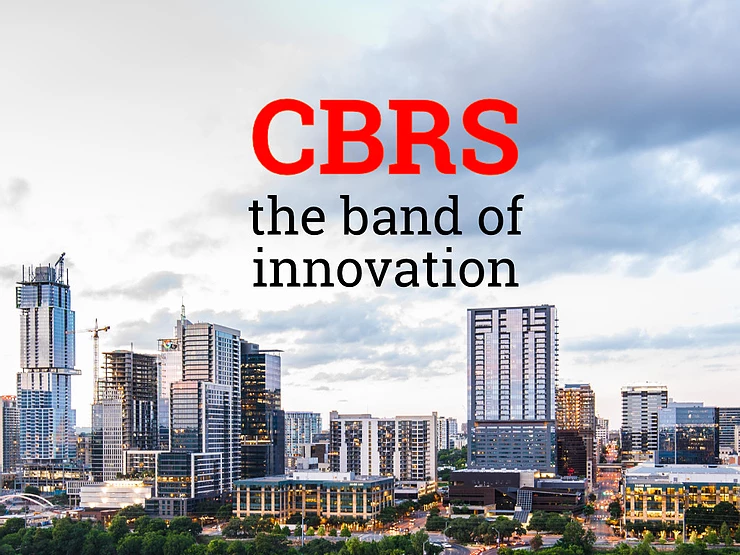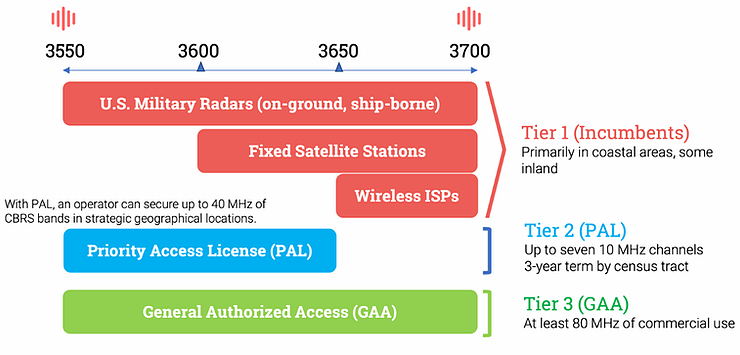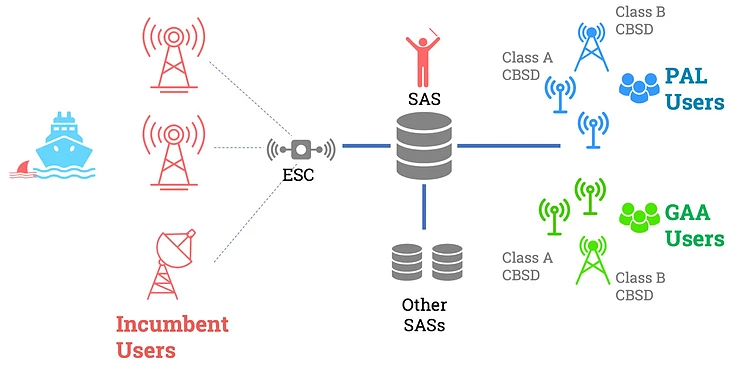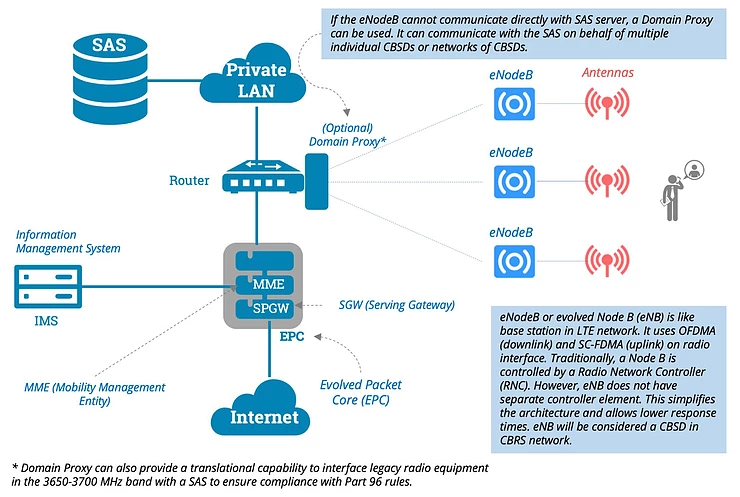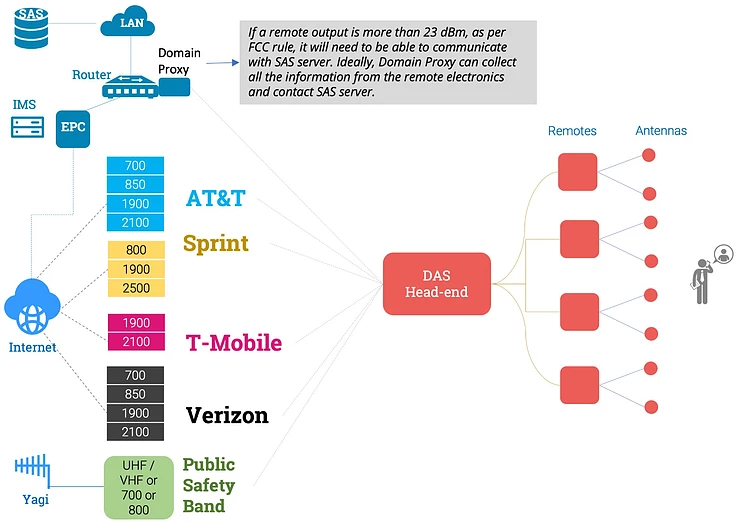Private LTE Network and CBRS in a DAS
When iPhone 11 was released many fans were upset that it was not going to support 5G.
The Verge: iPhone 11 will not support 5G
What was the big deal and why should we care about what Apple does? Because...
But iPhone 11 did give us another surprising headline:
What is band 48 and why is Apple interested in it?
150 Mhz is a pretty big deal. If data was coming through a pipe, think of this as the diameter of a fat pipe. How fat is this pipe?
Look at Verizon's total bandwidth. 150 MHz will be bigger than the combined bandwidth of Verizon's high and low bands or all of T-mobile's bands (before merger!).
FCC approved the initial commercial deployments of CBRS on September 16, 2019 (GAA). That's just barely 4 months ago from the time of this writing.
3 types of CBRS Users:
CBRS will classify all users into 3 groups to assign priority. These 3 groups are Incumbents, PAL and GAA users.
Tier-1 users are called 'Incumbent' and they will get the highest priority. Incumbent Access users include authorized federal users in the 3550-3700 MHz band, Fixed Satellite Service (space-to-Earth) earth stations in the 3600-3650 MHz band, and, for a finite period, grandfathered wireless broadband licensees or WISPs in the 3650-3700 MHz band. Incumbent Access users receive protection against harmful interference from Priority Access Licensees and General Authorized Access users. (Source)
Tier 2 users are PAL or Priority Access License Holders - and these can be businesses, rural WISPs and even qualifying tribal lands. According to FCC: "Priority Access Licenses (PALs) that will be licensed on a county-by-county basis through competitive bidding. Each PAL consists of a 10 megahertz channel. PALs are 10-year renewable licenses. For purposes of the PAL service, counties are defined using the United States Census Bureau’s 2017 counties."
In each county, there can be up to 7 PALs. Each license holder can have 10 MHz TDD channel. A license holder can buy up to 4-10 MHz channels, but not more than that (i.e. channel aggregation cap).
FCC will also implement a substantial performance requirement for the PALs by the end of the initial license term. PALs must protect and accept interference from Incumbent Access users but receive protection from General Authorized Access users. (Source)
PAL auction will take place on June 25 of 2020.
So organizations will need to assess very quickly how CBRS can fit into their roadmap, and if it is a tool they want to keep in their toolbox, businesses need to plan for that auction.
The General Authorized Access (GAA) users are the lowest priority users, although, GAA users won't have to pay for the use of the band. Following is how the GAA users will use CBRS:
Channels throughout the overall band (3550–3700 MHz) are available for GAA users. I already mentioned above that PAL and GAA users are not allowed to use CBRS channels while they are in use by incumbent users.
Access to 70 MHz is shared with PAL users and subject to availability (PAL users have priority over GAA users).
Access to the remaining 80 MHz is reserved for GAA access (but PAL users can also use this part of the band under the GAA provisions).
Spectrum Sensing & Coordination
With 3 tiers of users, naturally, the question comes up how do a CBRS system sense, direct and prioritize the traffic in the right direction? This is done through Spectrum Sensing & Coordination – unique, but the greatest feature of CBRS!
At the center of the spectrum sensing and coordination is SAS (Spectrum Access System).
The Spectrum Access System (SAS) is a cloud-based service that manages the wireless communications of devices transmitting in the CBRS band, in order to prevent harmful interference to higher priority users. (Source)
On January 27, 2020 FCC certified 4 companies - CommScope, Federated Wireless, Google, and Sony - will become Spectrum Access System (SAS) Administrators to manage access to the band. (Source)
A CBRS device or CBSD needs authorization from the SAS before it starts to transmit in the CBRS band. SAS is like a traffic controller or conductor of the orchestra.
Who else is in this spectrum sensing and coordination eco-system?
Tier 1 or Incumbent users have the priority to use the CBRS spectrum and does not need authorization from SAS. However, SAS needs to know when tier 1 users are communicating so that it can prevent the PAL and GAA users from creating interference during that communication.
How does SAS know when the Tier 1 users are transmitting? The answer is ESC sensors. The ESC (Environmental Sensing Capability) is a network of sensors that detects incumbent activity in the CBRS band mainly along the coast and sends that information to a SAS.
A CBRS Device (CBSD) needs authorization from the SAS before it starts to transmit in the CBRS band. The SAS has no way to proactively reach out to a CBSD, so the CBSD must initiate all communications. CBSDs communicate with the SAS using the SAS-CBSD API (Application Programming Interface). The Wireless Innovation Forum (WInnForum) establishes protocols for communication between CBSDs and the SAS. These protocols are implemented in the SAS-CBSD API.
There are 2 types of CBSDs - Class A and B. A class A base station (CBSD) can be thought of as indoor or low power outdoor small cells with a maximum power of 24 dBm (per 10 MHz) and maximum EIRP of 30 dBm (1 watt). Class A CBSD is similar to “enterprise-class” small cells.
A class B base station (CBSD) is meant for outdoor use with a maximum EIRP of 47 dBm (50 watts) intended to be used for fixed wireless purposes.
Important Entities
CBRS Alliance and OnGo
In 2016, six companies formed the CBRS Alliance. By mid-2018, the CBRS Alliance surpassed 100 members. (Source) The purpose of CBRS Alliance, in their own word, is to support the common interests of members, implementers and operators for the development, commercialization, and adoption of LTE solutions for the US 3.5 GHz CBRS.
OnGo was created by CBRS Alliance. CBRS Alliance says: "OnGo is uncompromised connectivity... OnGo presents nearly limitless options for enhanced customizability, effectively allowing you to tailor your network to a specific set of needs, such as IIoT applications or In-Building wireless or connectivity in public spaces." For practical definition though, think of OnGo as a certification program - A set of standards for performance and interoperability. It ensures seamless integration and deployment of OnGo wireless devices and solutions.
WInnForum
WInnForum is an industry-led group that defines requirements and protocols for using the CBRS band. WInnForum is an abbreviation of the Wireless Innovation Forum. Members of WInnForum include SAS administrators, CBRS equipment manufacturers, network operators, and training program administrators like Google.
Block Diagrams of Private LTE Network & CBRS through DAS
CBRS Private LTE Network
At the core of CBRS based Private LTE Network is eNodeB (eNB). eNB is considered to be a CBRS device or CBSD.
Block Diagram for a stand-alone CBRS Private LTE Network
eNodeB-s are connected to the SAS server through router and LAN. The router also provides a pathway for the eNB or CBSD to talk to the core network (EPC). If the eNodeB cannot communicate directly with the SAS server, a Domain Proxy can be used. It can communicate with the SAS on behalf of multiple individual CBSDs or networks of CBSDs. Note that, Domain Proxy can also allow legacy radio equipment in the CBRS band to interface with an SAS to ensure compliance with Part 96 rules.
Private LTE Network or dedicated CBRS network will allow organizations to implement use cases where secure, low latency and the high-quality network is required - for example, video surveillance, critical communications, automated guided vehicle support, industrial automation or remote equipment control. (Source)
CBRS through a Multi-Carrier DAS
In a multi-carrier DAS, signal sources from Mobile Network Operators (MNO) are added at the head-end.
How CBRS will be added to a traditional Neutral Host DAS
At a very high level, DAS head-end takes the RF signal from the MNO source, converts to an optical signal and distributes the optical signal via fiber to the electronics generally called ‘remotes’. These remotes convert the optical signal back to the RF signal and distribute it to the users through the antenna.
For a multi-carrier DAS to be CBRS compatible, it will have to pass through and process the signal at the head-end and at the remote end. Antennas (as well as other passive materials) will also have to be CBRS band compatible.
If a remote output is more than 23 dBm (and in most cases that will be the case), as per FCC rule, it will need to be able to communicate with the SAS server. Future DAS architecture may handle this in 2 ways:
1. Allow the remotes to be able to connect to the SAS server directly, or
2. Use Domain Proxy device. Ideally, Domain Proxy can collect all the information from the remote electronics and contact the SAS server.
My prediction is we will see the use of domain proxy devices more in future DAS releases.
We strongly recommend that when you add a CBRS compatible DAS component (remotes for example), make sure that they are OnGo certified.
How MNOs will use CBRS?
One of the promises of CBRS is to reduce customer's dependence on MNO for wireless communications. However, MNOs will also take advantage of the CBRS band. There are 2 ways MNOs can expand capacity with the CBRS band.
1. 3.5 GHz GAA spectrum bands can be used as supplemental data links while a licensed band is used as an “anchor” carrier for control signaling and a primary data path.
Adapted from: Kyung Mun, March 2017
2. TD-LTE on the CBRS bands can transport both control signaling and data traffic over the 3.5 GHz shared spectrum.
Adapted from: Kyung Mun, March 2017
In both cases, CBRS offers a higher level of network quality control with LTE-based solutions as compared to Wi-Fi offload.
10-MHz channels allow mobile operators to apply carrier aggregation to boost peak speeds and boost capacity. PAL licenses for outdoor deployments can be quite useful in guaranteeing a certain amount of spectrum in traffic hotspots.
With PAL licensing, mobile network operators can effectively secure up to 40 MHz of CBRS bands in strategic geographical locations. The operator can also utilize additional CBRS bands on the GAA basis and take advantage of extra spectrum resources.
Promise of CBRS
CBRS had been touted as a band of innovation for a reason. It will reshape, change and add value to a lot of different industries and sectors. For example, agriculture, financial, healthcare (e.g., hospitals, home care), hospitality (e.g., hotels), manufacturing, military, mining, oil, office buildings, corporate campuses, public agencies, public venues (e.g. stadiums, entertainment venues), retail (e.g., malls, shops), supply chain, distribution (e.g., warehouses, ports), transportation and transportation venues (e.g., airports, train stations), utilities, power generation, distribution, and many more.
From a feature and benefits perspective, there are also many benefits. I will just cite a few in this article:
Great for IIOT & enterprise-based application
CBRS brings to the enterprise the traffic management capabilities, capacity, latency, reliability, and security of LTE (and eventually 5G) that it needs for IIoT (Industrial IoT) and other enterprise-based applications, including voice.
Standalone
Enterprise can deploy standalone networks that can – but do not have to be tied to a mobile operator network.
Control & Security
It's hard to have mobile operators pay in full for a network (e.g., IOT) customized to meet its needs. By deploying a private or neutral host network, the enterprise can retain control over the network’s architecture and performance, management & security.
Simple
CBRS networks are less complex than large carrier-operated LTE networks. Easy to deploy and operate.
Better propagation characteristics
Higher regulatory power limits and better RF propagation characteristic of the lower 3.5 GHz band yields a longer range than the 5 GHz band.
Out-of-box solutions
CBRS small cell solutions will work out of the box and do not need a carrier-grade core network. All network components will come with the CBSD, along with network configuration tools. An enterprise just has to deal with RF planning and backhaul.
Less Baggage
Small cell densification has been slow to scale as projects are mired in municipal approval processes.
Wi-Fi market had been pushing back on Commercial Licensed Assisted Access (LAA) to launch the unlicensed 5 GHz spectrum. OnGo offers 150 MHz of sparsely used spectrum for LTE capacity expansion -- without the complexity of sharing the band with Wi-Fi.
CBRS industry is going through rapid development and changes in its device eco-system starting from radios to user handsets, modems, IoT devices, etc. There are quite a few unknowns though. At the time of this research, I did not find much information on how will CBRS hand-off to a cellular network, timeline of radio manufacturers (e.g., Ericsson, Nokia, Samsung) in integrating carrier signals into CBRS band, or how E911 call will be managed in CBRS band even if the CBSD is voice capable, etc. I am sure about one thing though the industry will solve those issues (if they haven't already) because CBRS is here to stay.
Summary:
CBRS (Band 48) is an FCC-mandated band of 150 MHz at 3.5 GHz.
It will have 3 tiers of users - Incumbent, PAL (Priority Access License), and GAA (General Authorized Access) users. The incumbent has the highest priority, and GAA has the lowest.
Auction for PAL bands is scheduled to start on June 25, 2020. PALs will be licensed on a county-by-county basis through competitive bidding. PALs are 10-year renewable licenses. In each county, there can be up to 7 PALs. Each license holder can have multiple of 10 MHz TDD channel depending on how many licenses they get
A license holder can buy up to 4-10 MHz channels, but not more than that.
At the center of the spectrum sensing and coordination is SAS (Spectrum Access System). The Spectrum Access System (SAS) is a cloud-based service that manages the wireless communications of devices transmitting in the CBRS band, in order to prevent harmful interference to higher priority users.
A CBRS device or CBSD needs authorization from the SAS before it starts to transmit in the CBRS band. SAS is like a traffic controller.
A Private LTE Network (i.e., CBRS network) can be standalone. At the core of Private LTE Network is eNodeB (eNB) or CBSD.
CBRS band can also be part of a neutral host DAS.
CBRS Alliance was formed in 2016. More than 100 companies are its members.
OnGo was created by CBRS Alliance. It is a set of standards for performance and interoperability. OnGo certification will become the de facto certification of the CBRS industry.
WInnForum is an industry-led group that defines requirements and protocols for using the CBRS band.
CBRS offers a higher level of network quality control with LTE-based solutions as compared to Wi-Fi offload. It will add value to a lot of different industries and sectors.
References:
Apple’s iPhone 11 doesn't have 5G because 5G isn’t ready for the iPhone
CBRS Alliance Passes 100-Member Milestone, Establishes OnGo™ Deployment and Operations Working Group
CBRS: Should the enterprise and venue owners care? Monica Paolini, Senza Fili
FCC AUTHORIZES FULL COMMERCIAL DEPLOYMENT IN 3.5 GHZ BAND, ADVANCING AMERICAN 5G LEADERSHIP
FCC green-lights commercial use of the coveted Consumer Broadband Radio Service band
Making Neutral Host a Reality with OnGo™. Kyung Mun, December 2018
OnGo: New Shared Spectrum Enables Flexible Indoor and Outdoor Mobile Solutions and New Business Models. Kyung Mun, March 2017 / Updated May 2018
